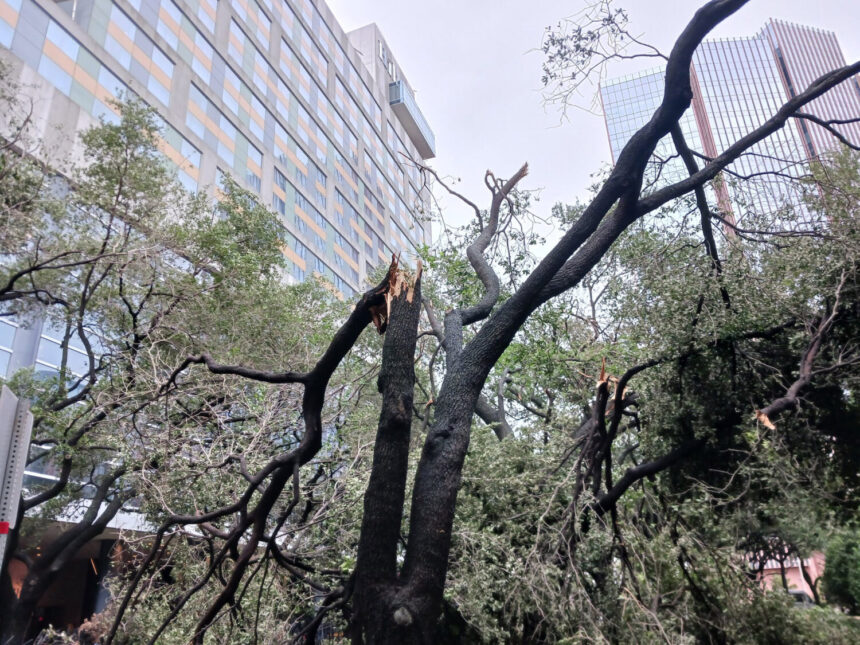Gail Delaughter/Houston Public Media
The hottest question around the Houston region on Tuesday — When will my power be back on?
That likely leaves around a million customers without power more than 48 hours after the storm hit as the heat and humidity cranks back up in the region.
RELATED: Heat advisory in effect across Houston after Beryl leaves millions without power
As of 6 p.m. Tuesday, more than 24 hours after the storm finished moving through the area, 1.5 million-plus CenterPoint Energy customers were still without power.
“The storm veered off the originally expected course and more heavily impacted the company’s customers, systems and infrastructure than previously anticipated,” CenterPoint said in a statement Monday afternoon.
The 2.2-million plus without power is more than double the 900,000-plus who lost power in May when a derecho unexpectedly hit the area. It took more than a week for those outages to be restored.
Lt. Gov. Dan Patrick, who is acting governor of Texas with Gov. Abbott out of the country, said Tuesday he wants answers from CenterPoint.
“CenterPoint will have to answer for themselves if they were prepared and positioned. The state was positioned and prepared. I’ll tell you whether I’m satisfied or not when I have a full report,” Patrick said.
Customers wanting more detailed information on outages and restoration will have to do without the company’s outages map. It was taken offline in the wake of the derecho and remained offline as Beryl hit.
According to a press release on Sunday, CenterPoint initially mobilized 4,500 workers, including lineworkers, vegetation management workers and mutual aid resources. By Monday afternoon, the utility company said it was increasing the supplementary workforce to 10,000.
While some customers have gotten power back, CenterPoint officials say workers need more time to assess damage.
“It’s going to be at least a few days for us to really complete that damage assessment,” said Alyssia Oshodi, CenterPoint Energy’s Director of Communications, on Tuesday. “While we can’t give a definitive timeline yet, because we are still just in day one, it’s going to be a prolonged outage-restoration time.”
Oshodi said residents should not call CenterPoint to report outages.
“We really encourage customers to keep our phone lines open unless they have an emergency, such as a downed line that needs to be reported or another hazard,” she said.
University of Houston Energy Fellow Ed Hirs warned people it could take a long time to get outages restored.
“A good rule of thumb is two to three weeks if the city takes a direct hit,” Hirs said. “It just takes a lot of manual effort to string these wires and do it in a way that’s safe. It’s very dangerous work, and it has to be done correctly.”
A path to resiliency?
Hirs says preventing a similar widespread outage situation will be costly.
“It’s very expensive to weather-harden a distribution grid across the city,” he said. “Buried lines really can’t be installed after a city has sprung up around it. It costs a huge amount of money to weave lines underneath already existing utilities, sewer water, gas lines, roads.”
Instead of burying lines, Hirs believes CenterPoint needs to install more resilient distribution poles. But even this process is expensive and controversial.
He pointed to the Montrose neighborhood, where the utility company installed nearly 50 weather-resilient poles over the last year. Residents complained about blocked sidewalks and argued the poles were eyesores.
“My god, the furor was astonishing,” Hirs said. “These are the big, storm-hardened poles that are supposed to take hurricane force winds.”
In a press release Monday afternoon, CenterPoint pointed to the late changes in the forecast and said that complicated their planning and restoration efforts.
“Keep in mind, it’s a Fourth of July weekend, and it’s difficult to mobilize thousands of men and women and trucks and equipment on such short notice,” Hirs said. “The fact that the storm turned to the north and essentially to the east of where it was originally expected to go certainly played into that.”
In the aftermath of Winter Storm Uri in 2021, the Texas Legislature focused much of its attention on shoring up the supply of power by investing billions of dollars in natural gas plants.
“The state is obviously spending a lot of money right now, billions and billions of dollars to give loans and grants to natural gas plants to come online,” energy consultant Doug Lewin said. “That’s focused on one particular kind of problem, which is times when we don’t have enough supply to meet demand, but those solutions, despite all the money that’s spent, don’t do anything when there’s a hurricane.”










